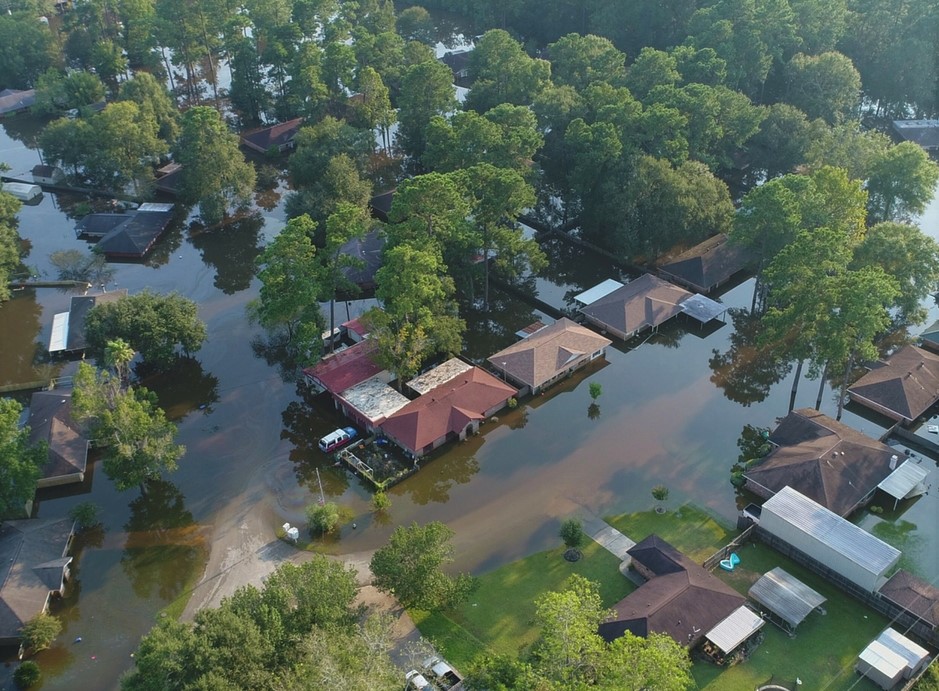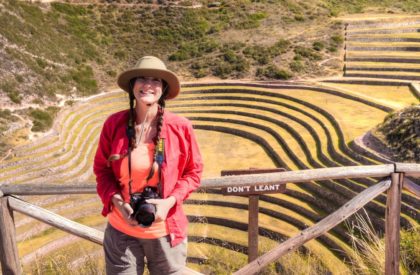Apply now to join our next cohort of Community Science Fellows and Community Leads!

Hurricane Harvey, Sept. 2017, in Hardin County. Photo credit: Reagan Gillespie, Altus Emergency Center
Hardin County, located in Southeast Texas, is an area subject to recurrent and intensifying flooding. Half of the county lies in a floodplain. This area is home to a rural population of 55,000 residents living in 25,000 homes—20% of these homes flooded during Hurricane Harvey. The community’s natural landscape, the Big Thicket, consists of diverse floodplains, wetlands, and bayou ecosystems, offering tremendous natural resilience to mitigate this flooding. Unfortunately, much of this resilience has been tempered by urban growth. While numerous grey–infrastructure approaches (ditches, drains, detention ponds, and canals) have been implemented over the years, they are continuously overrun as urban development brings additional impermeable surfaces to the area.
The Big Thicket Biosphere Reserve, the main community partner for this project, is associated with the Big Thicket National Preserve, in Hardin County, with a focus on putting people at the center of conservation. Through its community-based Man and Biosphere Program, they are engaging community leaders to help restore the floodplains that once served to absorb floodwaters and protect residents. However, the resilience of the natural landscape to mitigate flooding is diminishing with urban growth and hard infrastructure. Today, the Biosphere collaborates with community partners to develop more sustainable solutions to recurrent devastating flooding by re‐introducing floodplain function to the occupants of the region. The Biosphere works with communities in landscape planning efforts by planting trees, removing trash from streams, trailheads, and boat ramps, and also participates in roundtable discussions for additional Big Thicket trail development.
The purpose of this project is to create a local survey that will shed light on the perceptions, viewpoints, and visions of residents and elected officials related to flood-resilience, traditional flood-management strategies, and alternative, nature-based mitigation. The results of this survey will be used to understand and address community hesitancy and political inertia towards nature-based solutions to local flooding. Survey results will also be used to further shape outreach materials used to advance community familiarity with and understanding of nature-based flood mitigation.
In a later phase of this project, community leaders with the Big Thicket Biosphere Reserve hope to use the information collected in the local survey to engage residents in building a flood-resilient community using productive and cost-effective nature-based solutions. They intend to build awareness amongst local government and community leaders on the need to understand and address the social dimensions of recurrent flooding and ways to integrate relevant nature-based solutions. By learning from community stories and understanding why residents stay in areas that flood repeatedly, community leaders with the Big Thicket Biosphere Reserve hope to actively work with residents to reintroduce natural floodplain function and create a more sustainable future.
The collaboration between the community and the scientist(s) should start as soon as possible. The duration of the project will be approximately 12 months.
Ultimate timeline and milestones will emerge once the scientist(s) is brought on board and as the project is planned in detail.

Mary Bernard: Director of the Big Thicket Biosphere Reserve, is a retired 30-year veteran of southwestern archaeology with a background in journalism. She has a great interest in the rich cultural and natural heritage of southeast Texas. She holds a Master’s in Quaternary Geology and Archaeology from the Université de Bordeaux and a Master’s in Anthropology from the University of Arizona.

Ellen Buchanan: President of the Big Thicket Natural Heritage Trust, grew up in the Big Thicket area. After retiring from Texas Parks and Wildlife State Parks, she returned to work with the Big Thicket Natural Heritage Trust, whose main goal is to advocate for and protect the Preserve. She currently serves on the Texas Water Development Board Neches River Flood Planning Group, charged with developing the watershed flood plan to protect both people and property in the local community.

Cary Dupuy, Texas Regional Director, NPCA, leads initiatives to connect people, communities, and businesses with their parks and facilitate opportunities to protect and enhance national park sites in Texas and Oklahoma. A native of east Texas, Cary holds Big Thicket as a special place to conserve to ensure the cultural and natural heritage held in the region are preserved. Cary earned degrees in History and Public Administration from Texas Tech University.

Erika Pelletier, Associate Director, NPCA, works to support the 18 national parks in Texas and Oklahoma and their communities. As a native Texan, Erika understands how important the Texas landscape is to its people, but spends the majority of her time in the “Big” parks – Big Bend National Park and Big Thicket National Preserve – working on large landscape restoration and sustainability. Prior to joining NPCA Erika received her Bachelor of Science in Computer Science from Texas Wesleyan University.

Shelby Johnston is a geochemistry researcher and science-outreach enthusiast. She works with multiple nonprofit programs to bring Earth-science education to underfunded communities. Shelby also serves on the Executive Committee of the International Association for Geoscience Diversity, a nonprofit that improves disability inclusion in geoscience. She holds a Ph.D. in Geology from the University of Houston and a B.S. in Geology from Louisiana State University. In her free time, she can often be found exploring the outdoors.
This project seeks a scientist to support community leaders in developing and analyzing a local community survey that answers questions such as:
Desired Skills
Thriving Earth Exchange asks all technical partners to work with the community to help define a project with concrete local impact to which they can contribute as pro-bono volunteers and collaborators. This work can also position the scientists and communities to seek additional funding together for the next stage.
The Big Thicket Biosphere Reserve is part of the US Biosphere Network and the UNESCO Man and Biosphere Program. Recognized in 1981, the Big Thicket Biosphere of southeast Texas is a region of tremendous biodiversity, scientific research significance, and deep cultural roots reflected in the lives and livelihoods of its people.
The National Parks Conservation Association is the voice of America’s national parks, working to protect and preserve our nation’s most iconic and inspirational places for present and future generations. For more than a decade, NPCA has served as a leader in building a more resilient Big Thicket, investing time and resources alongside local organizations and community stakeholders to restore, revive and renew this unique region.
(c) 2024 Thriving Earth Exchange